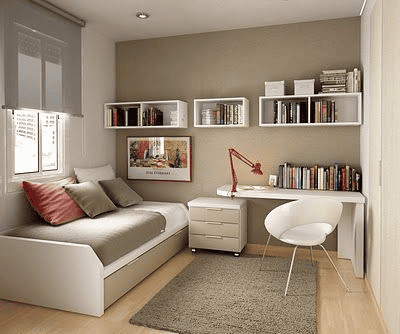As temperatures rise and the intensity of summer heat mounts in India, the pursuit of indoor comfort becomes paramount. Your trusty air conditioner acts as a bulwark against the sweltering conditions, but selecting the right one is no small feat. A crucial yet overlooked consideration is determining the correct AC capacity relative to your room size. While this may seem straightforward at a glance, many nuanced factors come into play.
Beyond just the room’s dimensions, aspects such as climate, room orientation, furnishings, and everyday activities all influence your cooling needs.
This guide delves into the intricacies of choosing the ideal AC capacity based on room size, aiming for optimal cooling efficiency, energy savings, and overall comfort. We’ll unpack the essential considerations when deciding on AC tonnage, equipping you with the knowledge to make an informed decision that aligns with your needs.
Whether grappling with relentless heat, a sun-soaked space, or rooms filled with heat-generating appliances, each factor holds significant sway in your ultimate choice.
Join us as we navigate the complexities of selecting the right AC capacity based on room size in India. We’ll dispel common myths and provide insights to help you create a tranquil oasis during the hottest summer days. Dive into the nuanced relationship between room dimensions, tonnage, and other essential factors, guiding you toward efficient cooling and optimised energy consumption.
Table of Contents
What Room Size Calls for a 1 Ton AC?

Achieving the right cooling balance and comfort in your space hinges on selecting the correct tonnage for your air conditioner. The process is simpler than expected: start by measuring your room’s area in square feet. Divide that figure by 600 to establish the basic cooling capacity.
For instance, if your room occupies 100 square feet, the calculation reads as follows:
100 / 600 = 0.167
For more precision, factor in the room’s occupants. Adding 0.5 Tons for every 5 people yields the exact tonnage needed. As a general guideline, a 0.8 Ton AC usually suits a 100 square feet room.
Whether for your snug living area or a revitalising workspace, this direct calculation method empowers you to identify the optimal tonnage, ensuring a comfortably chilled environment.
Factors to Consider While Deciding AC Tonnage
| Factors to Consider | Tonnage |
| Severe Heat Conditions (Above 45 Degrees Celsius) | Add extra 0.5 Ton |
| Terrace Location or Direct Sunlight Exposure | Add extra 0.5 Ton |
| Heat-Generating Activities within Home | Add extra 0.5 Ton |
| Furniture Types and Arrangement | Depends |
| Storage of Papers or Books | Add extra 0.5 Ton |
| Room Height and Length (>12 feet) | Add extra 0.5 Ton |
| Usage of Inverter Stabiliser with AC | Everywhere expect metropolitan cities |
| Basic Capacity Calculation: 100 sq ft / 600 = 0.167 | Add extra 0.5 Ton |
Extremely Hot Weather

n hot regions, the need for potent cooling escalates. Warm climates demand increased cooling capacity for indoor comfort. To tackle this, it’s wise to boost the recommended tonnage by 0.5 Ton or more.
For instance, if you’re contending with temperatures exceeding 45 degrees Celsius, adding an extra 0.5 Ton or more to your AC’s capacity is essential. This tweak recognises the severity of extreme weather, empowering your air conditioner to battle the heat and uphold a revitalising indoor environment effectively.
Terrace Flat or Direct Sunlight

Direct sunlight and a terrace setup significantly impact your cooling needs. Rooms exposed to sunlight or located on the top floor with an open terrace require additional cooling power.
Consider adding an extra 0.5 Tons or more to your AC’s capacity to address sunlight and terrace exposure.
Heat Producing Work at Home

Home-based activities that generate heat have a direct impact on indoor temperatures. Rooms with significant heat-producing tasks require specific attention.
When involved in such tasks, your AC faces an additional load due to the generated heat. To counter this, it’s advisable to consider a higher tonnage AC.
Type of Furniture

The type of furniture you have at home plays a significant role in your AC’s workload. Furniture affects heat absorption and distribution within a room, with its impact varying based on the furniture type.
Furniture classification includes wood and metal. Wooden furniture influences AC load as follows:
- For rooms with 100 sq feet and wooden furniture, a 1 Ton AC suffices.
- For 120 sq feet rooms with more wooden furniture, a 1 Ton AC is suitable.
- Rooms exceeding 190 sq feet with substantial wooden furniture require a 1.5 Ton AC.
- Rooms surpassing 300 sq feet with abundant wooden furniture benefit from a 2 Ton AC.
Metal furniture affects cooling differently:
- In rooms of 120 sq feet with metal furniture, opt for a 1.5 Ton AC.
- For 190 sq feet rooms with metal furniture, consider a 2 Ton AC.
Notably, more metal furniture absorbs both heat and cold, making wooden furniture the preferable choice.
Rooms with More Paper or Books

The presence of paper and books impacts cooling needs, elevating humidity levels and demanding unique cooling solutions.
Accumulated paper or books raise the room temperature. Consequently, smaller rooms require higher-capacity AC units for effective cooling.
For instance:
- In a 100 sq feet room, usually suited for a 1 Ton AC, paper/books mandate a 1.5 Ton AC.
- Similarly, a 200 sq ft room, typically using a 1.5 Ton AC, necessitates a 2 Ton AC to counter paper/book-generated heat.
To adeptly manage distinct cooling needs, consider tailored tonnage adjustments (additional 0.5 Ton) aligning with your room’s attributes.
Long or Heighted Room (>12 feet)

The dimensions and height of a room significantly influence air circulation and cooling effectiveness. Rooms with extra height or length demand specific considerations.
In rooms exceeding 12 feet in height, a 1 Ton AC may struggle to provide even cooling throughout the entire space. To address this, you have options:
- Place a tower fan strategically to facilitate air circulation to all corners.
- Alternatively, opt for a more suitable solution: a 1.5 Ton AC.
By incorporating a tower fan or upgrading AC tonnage, you ensure proper cooling distribution, tackling the challenge posed by taller or lengthier rooms. This way, you create a consistently comfortable environment, regardless of your room’s dimensions.
Inverter Stabiliser Usage

Inverter stabilisers influence AC needs, but the demand for extra tonnage varies by location.
Metropolitan zones with fewer power cuts generally skip stabilisers or inverters. In non-metropolitan cities, though, an inverter or stabiliser is crucial.
This differentiation underscores the need to adapt AC capacity according to power stability, guaranteeing efficient cooling. Consider adding 0.5 Ton to account for this factor.
How Much Area Does a 1 Ton AC Cover?

Understanding the coverage area of a 1 Ton AC involves grasping its general cooling capacity. However, precision requires considering individual room attributes alongside tonnage.
This evaluation is rooted in British Thermal Units (BTU). To elaborate:
- A 0.8-Ton AC equals 9000 BTU
- A 1-Ton AC equals 12000 BTU
- A 1.25-Ton AC equals 15000 BTU
- A 1.5-Ton AC equals 18000 BTU
A straightforward formula exists to compute your suitable BTU AC:
Room area in sq ft * 25 BTU – yields the BTU required.
For instance, 110 sq ft * 25 = 2650 BTU.
However, the calculation isn’t solely reliant on this. Additional considerations include:
- If your room remains shaded (sans direct sunlight), deduct 10% from the total BTU.
- With each extra person in the room, add 600 to 700 BTU to the total.
- Kitchens tend to be warmer, warranting an additional 2000 to 3000 BTU.
This nuanced approach ensures accurate cooling calculations personalised to your space’s distinctive attributes.
Impact of Oversized AC in Small Rooms

Utilising a 1.5 Ton AC in a smaller room brings about efficiency and comfort concerns. Oversizing an AC leads to energy wastage and discomfort.
At times, due to convincing sales tactics, individuals end up with an AC larger than needed. Despite recommendations for a 1.5 Ton AC in a standard room, this often leads to excessive cooling, making the room excessively cold.
In some instances, connecting an adjoining room redistributes the excess cooling. While a pragmatic solution, it’s not the intended outcome.
This experience underscores the importance of proper AC sizing. It’s clear that a small room requires no more than a 0.8 Ton AC, especially if there are fewer than four occupants. This insight emphasises the significance of accurately matching AC capacity with room size to avoid discomfort, energy waste, and unwarranted expenses.
Room Size Exceptions: 12×12 Rooms and High Ceilings

Air conditioning choices become intricate when dealing with distinct room dimensions and features. Notably, 12×12 rooms and spaces with lofty ceilings present specific challenges, necessitating thoughtful tonnage selection for optimal cooling ease.
For rooms spanning 100 to 130 square feet, a 0.8 to 1 Ton AC generally suffices. As the area expands to 130 to 200 square feet, a 1.5 Ton AC proves more efficient. Larger spaces exceeding 200 square feet might benefit from a 2 Ton AC to enhance cooling capacity. When the area surpasses 500 square feet, multiple AC units should be considered for comprehensive coverage.
The complexity deepens with high ceilings, impacting air distribution and cooling efficiency. To counteract this, slightly elevating tonnage helps maintain uniform cooling throughout the space, offsetting the ceiling’s impact.
Incorporating these insights into tonnage decisions for distinctive rooms ensures your air conditioner is equipped to deliver sought-after comfort.
Efficiency and Budget Considerations for a 1 Ton AC

Selecting the right air conditioner hinges on merging cooling efficiency and budget priorities. Opting for a 1 Ton AC versus a larger capacity involves crucial assessments of performance and expenses.
Often, the dilemma revolves around choosing between a smaller or larger AC. A lesser capacity can struggle to cool effectively, raising energy bills, while an oversized AC amplifies energy consumption. Attaining equilibrium demands precise AC sizing according to your room’s specifics.
The efficiency of a 1 Ton AC extends beyond cooling—it affects your wallet too. By sizing accurately, it achieves a balance between cooling performance and budget-friendliness. This ensures your cooling needs are met while minimising needless energy costs.
Also Read
- How to Hide or Decorate Split AC Pipe
- Using AC in Kitchen: Is It a Good Idea?
- How to Install Window AC: 5 Essential Steps for Installing A Window AC Unit Correctly
Conclusion
Throughout this discussion, it’s clear that choosing the right AC capacity involves more than just basic considerations. Various examples emphasise the need to delve deep and assess the unique specifics of one’s situation.
Selecting an undersized AC might result in insufficient cooling, whereas an oversized unit can lead to excessive electricity use and higher bills. Achieving the perfect balance requires an in-depth understanding of many factors, not just room size. This includes the local climate, exposure to sunlight, activities that produce heat, the presence of furniture, and more.
As the saying goes, “Look before you leap.” The complexities touched upon emphasise the range of factors to consider before making a final choice, even down to the brand.
By taking into account all these variables, you can ensure effective cooling tailored to your specific requirements, all while reducing energy wastage and unnecessary costs. If you have any questions, insights, or suggestions, please share them in the comments below. We greatly value your feedback.
FAQs
Is room size the only factor to consider when choosing AC capacity?
No, room size is a significant factor, but other elements like climate, sunlight exposure, furniture, and even the number of occupants play a role in determining the appropriate AC capacity. For details, refer to the blog post mentioned above.
How do I determine the right AC capacity for a room with high ceilings?
Rooms with elevated ceilings may require slightly higher tonnage due to altered air distribution. It’s recommended to consider a slightly larger AC to maintain even cooling throughout the space.
What’s the impact of using an oversized AC in a small room?
An oversized AC in a small room can lead to overcooling, energy wastage, and discomfort. Choosing the right tonnage that aligns with your room’s size is important for efficient cooling.
How do paper and books in a room affect AC capacity?
Paper and books contribute to higher humidity levels, necessitating extra cooling. For rooms with extensive paper/book storage, adding 0.5 Tons to the recommended AC capacity is advisable.





